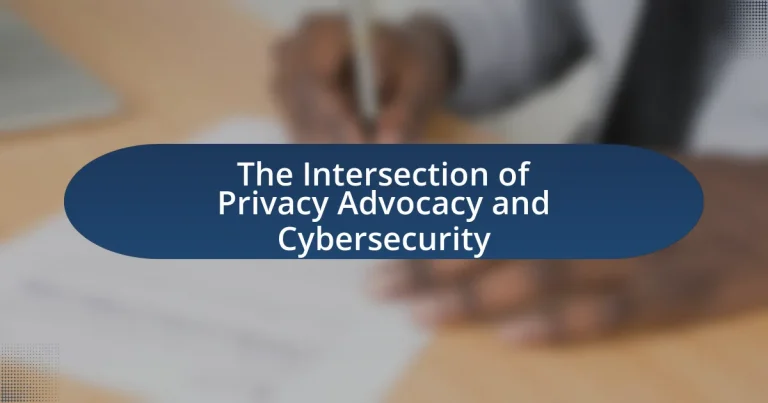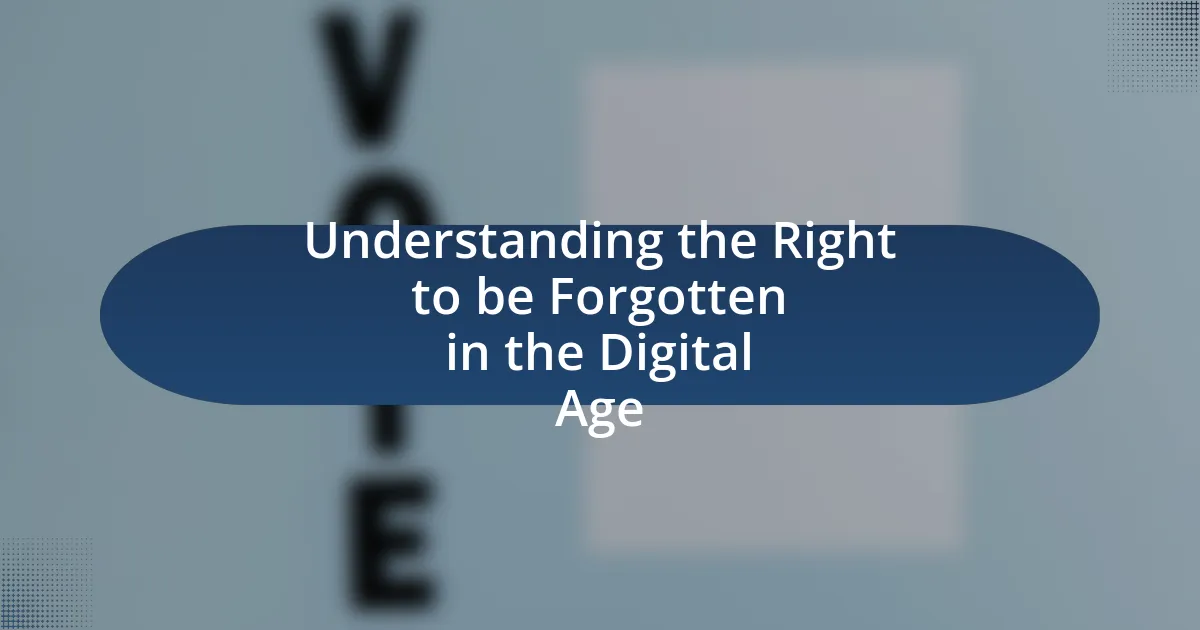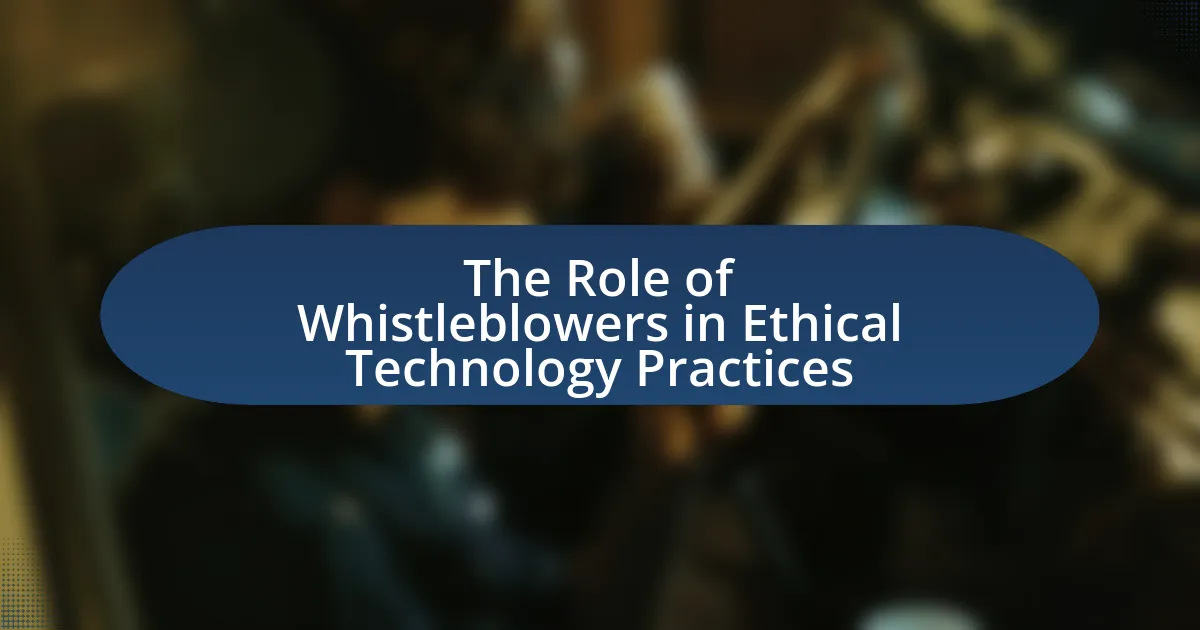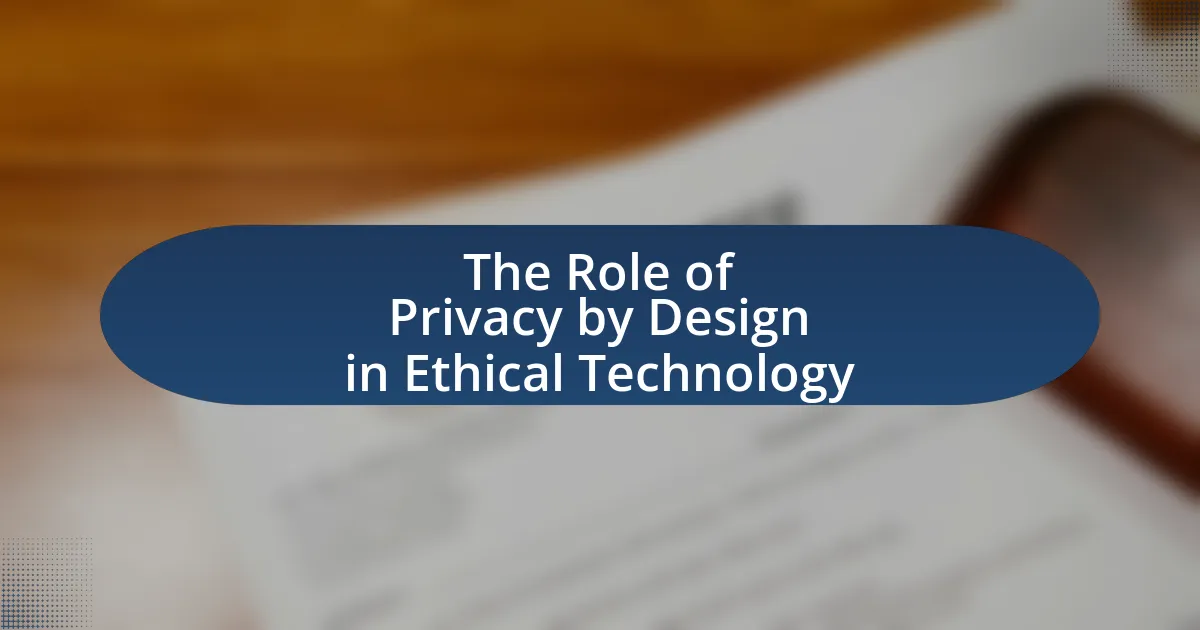The article examines the intersection of privacy advocacy and cybersecurity, emphasizing their shared objective of protecting personal information from unauthorized access and misuse. It outlines the relationship between privacy advocacy principles, such as transparency and consent, and cybersecurity measures that safeguard data, particularly in light of regulations like the General Data Protection Regulation (GDPR). The discussion highlights recent events that underscore the need for stronger privacy protections, the challenges faced in balancing privacy rights with security measures, and best practices for organizations to enhance both privacy and security. Additionally, it explores future trends and the implications of emerging technologies and global privacy regulations on cybersecurity practices.
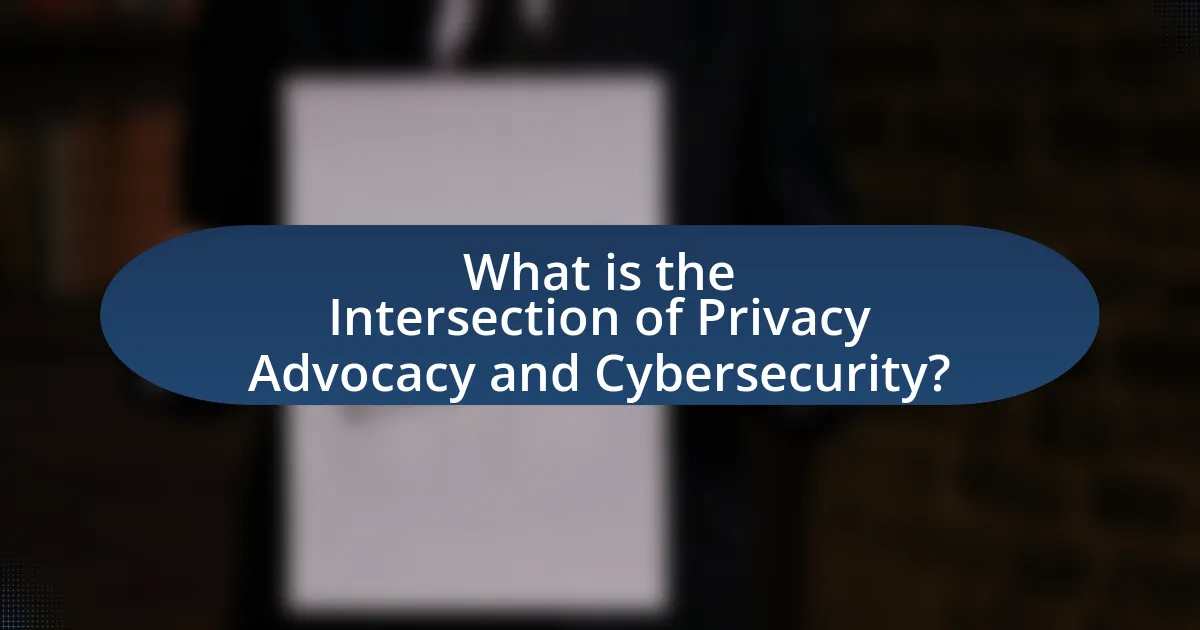
What is the Intersection of Privacy Advocacy and Cybersecurity?
The intersection of privacy advocacy and cybersecurity lies in the shared goal of protecting individuals’ personal information from unauthorized access and misuse. Privacy advocates emphasize the importance of safeguarding personal data and ensuring that individuals have control over their information, while cybersecurity professionals focus on implementing technical measures to defend against cyber threats. For instance, the General Data Protection Regulation (GDPR) in Europe mandates strict data protection standards, which cybersecurity measures must support to ensure compliance and protect user privacy. This synergy highlights the necessity for collaboration between privacy advocates and cybersecurity experts to create comprehensive strategies that address both legal and technical aspects of data protection.
How do privacy advocacy and cybersecurity relate to each other?
Privacy advocacy and cybersecurity are interconnected as both aim to protect individuals’ personal information from unauthorized access and misuse. Privacy advocacy focuses on ensuring that individuals have control over their personal data and that their rights are respected, while cybersecurity involves implementing technical measures to safeguard that data from breaches and cyber threats. For instance, the General Data Protection Regulation (GDPR) emphasizes the importance of data protection, which aligns with cybersecurity practices that prevent data breaches. Thus, effective cybersecurity measures support privacy advocacy by creating a secure environment where personal data can be managed responsibly.
What are the key principles of privacy advocacy?
The key principles of privacy advocacy include transparency, consent, data minimization, purpose limitation, and accountability. Transparency ensures that individuals are informed about how their data is collected and used, fostering trust. Consent requires that individuals give explicit permission for their data to be processed, emphasizing autonomy. Data minimization advocates for the collection of only the necessary information, reducing exposure to risks. Purpose limitation mandates that data be used solely for the stated purpose, preventing misuse. Accountability holds organizations responsible for their data practices, ensuring compliance with privacy laws and ethical standards. These principles are foundational in promoting individual rights and protecting personal information in the digital age.
How does cybersecurity support privacy advocacy efforts?
Cybersecurity supports privacy advocacy efforts by providing the necessary tools and frameworks to protect personal data from unauthorized access and breaches. Effective cybersecurity measures, such as encryption, firewalls, and intrusion detection systems, help safeguard sensitive information, thereby reinforcing the principles of privacy advocacy. For instance, the implementation of the General Data Protection Regulation (GDPR) in Europe mandates organizations to adopt robust cybersecurity practices to ensure the protection of personal data, demonstrating a direct link between cybersecurity and privacy rights. This regulatory framework not only enhances data security but also empowers individuals by giving them greater control over their personal information, aligning with the goals of privacy advocacy.
Why is the intersection of these fields important today?
The intersection of privacy advocacy and cybersecurity is crucial today because it addresses the growing concerns over data protection and individual rights in an increasingly digital world. As cyber threats escalate, privacy advocates emphasize the need for robust security measures that not only protect data but also uphold user privacy rights. For instance, the implementation of regulations like the General Data Protection Regulation (GDPR) in Europe has highlighted the necessity for organizations to integrate privacy considerations into their cybersecurity strategies. This integration is essential to build trust with users and comply with legal standards, ultimately safeguarding both personal information and organizational integrity.
What recent events have highlighted the need for privacy advocacy in cybersecurity?
Recent events such as the 2021 Colonial Pipeline ransomware attack and the 2022 Facebook data breach have underscored the urgent need for privacy advocacy in cybersecurity. The Colonial Pipeline incident resulted in significant fuel supply disruptions across the Eastern United States, highlighting vulnerabilities in critical infrastructure and the potential for widespread impact on public safety. Similarly, the Facebook data breach exposed the personal information of over 500 million users, raising concerns about data protection and user privacy. These incidents demonstrate that inadequate cybersecurity measures can lead to severe consequences, reinforcing the necessity for stronger privacy advocacy to protect individuals and organizations from similar threats in the future.
How do public perceptions of privacy influence cybersecurity practices?
Public perceptions of privacy significantly influence cybersecurity practices by shaping organizational policies and consumer behaviors. When the public prioritizes privacy, companies are more likely to adopt robust cybersecurity measures to protect sensitive data, as seen in the implementation of the General Data Protection Regulation (GDPR) in Europe, which was largely driven by heightened privacy concerns among citizens. Research indicates that organizations that fail to align their cybersecurity practices with public expectations risk losing customer trust and market share, as evidenced by the fallout from high-profile data breaches that resulted in significant financial losses and reputational damage. Thus, the interplay between public perceptions of privacy and cybersecurity practices is critical for maintaining trust and compliance in the digital landscape.
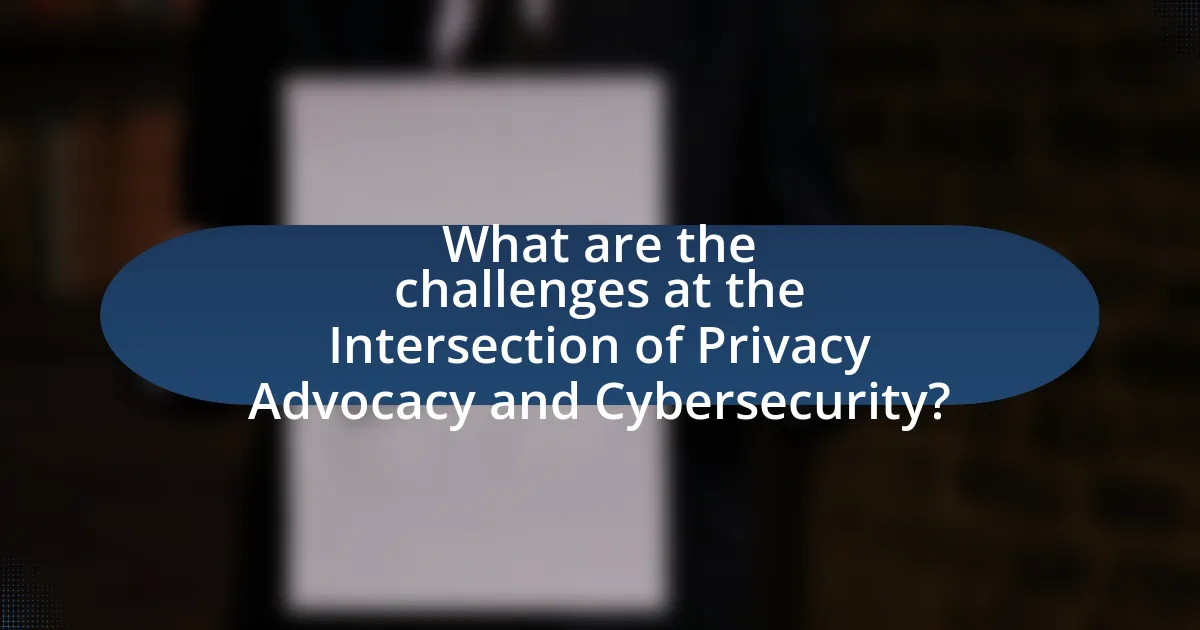
What are the challenges at the Intersection of Privacy Advocacy and Cybersecurity?
The challenges at the intersection of privacy advocacy and cybersecurity include balancing individual privacy rights with the need for security measures. Privacy advocates often argue that extensive surveillance and data collection infringe on personal freedoms, while cybersecurity professionals emphasize the necessity of these practices to protect against threats. This tension is evident in regulations like the General Data Protection Regulation (GDPR), which aims to protect personal data but can complicate cybersecurity efforts by imposing strict compliance requirements. Additionally, the rapid evolution of technology creates a landscape where privacy concerns may lag behind security advancements, leading to potential vulnerabilities.
What are the main threats to privacy in the digital age?
The main threats to privacy in the digital age include data breaches, surveillance, and inadequate data protection laws. Data breaches occur when unauthorized individuals access sensitive information, with 2020 witnessing over 37 billion records exposed globally, according to the Identity Theft Resource Center. Surveillance, both by governments and corporations, compromises individual privacy through monitoring online activities and communications. Additionally, inadequate data protection laws, such as the lack of comprehensive regulations in many countries, leave individuals vulnerable to misuse of their personal information. These factors collectively undermine privacy rights and highlight the urgent need for stronger protections in the digital landscape.
How do data breaches impact individual privacy rights?
Data breaches significantly undermine individual privacy rights by exposing personal information to unauthorized access and misuse. When sensitive data such as social security numbers, financial details, or health records are compromised, individuals face risks including identity theft, financial fraud, and loss of control over their personal information. According to the Identity Theft Resource Center, in 2021, over 1,800 data breaches were reported in the United States alone, affecting millions of individuals and highlighting the pervasive threat to privacy rights. These breaches not only violate legal protections, such as the General Data Protection Regulation in Europe, but also erode public trust in organizations that fail to safeguard personal data.
What role do government regulations play in protecting privacy?
Government regulations play a crucial role in protecting privacy by establishing legal frameworks that dictate how personal data must be handled by organizations. These regulations, such as the General Data Protection Regulation (GDPR) in the European Union, impose strict requirements on data collection, storage, and processing, ensuring that individuals have control over their personal information. For instance, GDPR mandates that organizations obtain explicit consent from individuals before processing their data, thereby enhancing user autonomy and privacy rights. Additionally, regulations often include provisions for penalties and fines for non-compliance, which incentivizes organizations to prioritize data protection. This regulatory oversight is essential in an era where digital data is increasingly vulnerable to misuse and breaches, thereby reinforcing the importance of privacy in the digital landscape.
How do organizations balance cybersecurity measures with privacy concerns?
Organizations balance cybersecurity measures with privacy concerns by implementing data protection frameworks that prioritize both security and individual privacy rights. For instance, many organizations adopt the General Data Protection Regulation (GDPR) guidelines, which mandate that personal data must be processed securely while ensuring individuals’ privacy is respected. This dual approach is reinforced by employing technologies such as encryption and anonymization, which protect sensitive information from unauthorized access while allowing organizations to maintain necessary security protocols. Additionally, regular privacy impact assessments help organizations identify potential risks and mitigate them without compromising cybersecurity efforts.
What are common conflicts between security protocols and privacy rights?
Common conflicts between security protocols and privacy rights arise when measures designed to enhance security infringe upon individual privacy. For instance, surveillance systems implemented for national security can lead to unauthorized data collection, violating the right to privacy as outlined in various legal frameworks, such as the General Data Protection Regulation (GDPR) in Europe. Additionally, data encryption, while essential for protecting sensitive information, can hinder law enforcement’s ability to access data during criminal investigations, creating a tension between public safety and individual privacy rights. These conflicts highlight the ongoing struggle to balance the need for security with the fundamental rights of individuals.
How can organizations implement privacy-by-design in cybersecurity strategies?
Organizations can implement privacy-by-design in cybersecurity strategies by integrating privacy considerations into the development and deployment of their systems and processes from the outset. This involves conducting privacy impact assessments during the design phase, ensuring data minimization by only collecting necessary information, and incorporating strong encryption methods to protect personal data.
Additionally, organizations should establish clear data governance policies that define roles and responsibilities for data protection, provide regular training for employees on privacy best practices, and implement robust incident response plans to address potential data breaches. Research indicates that organizations adopting privacy-by-design principles can reduce the risk of data breaches by up to 30%, highlighting the effectiveness of proactive privacy measures in enhancing overall cybersecurity.
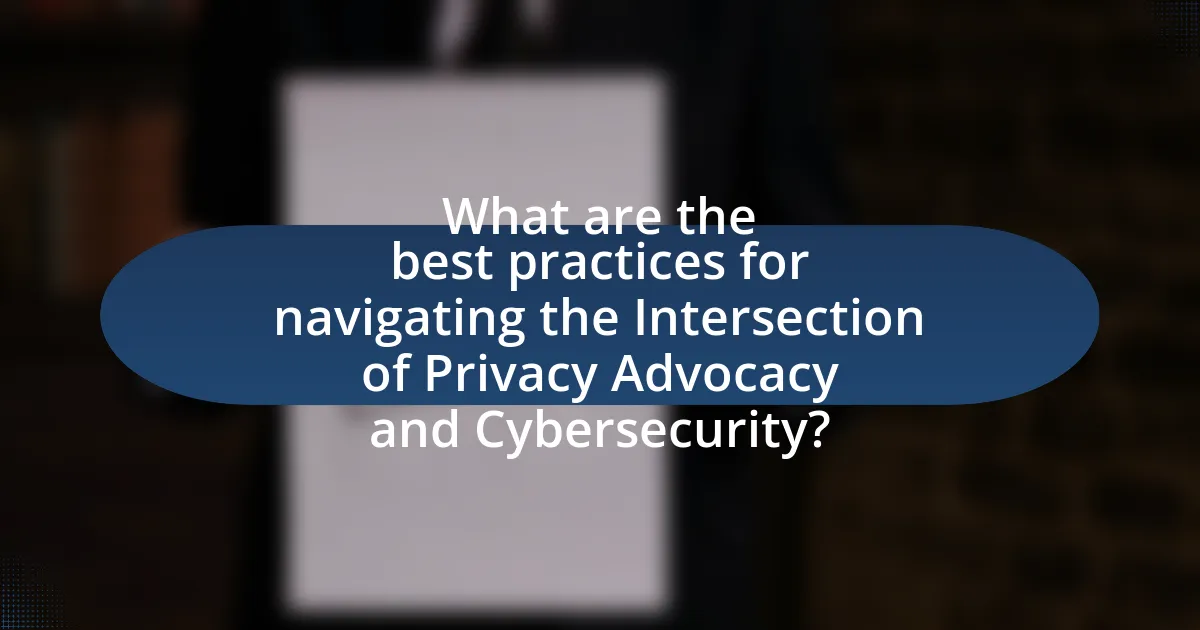
What are the best practices for navigating the Intersection of Privacy Advocacy and Cybersecurity?
The best practices for navigating the intersection of privacy advocacy and cybersecurity include implementing robust data protection measures, fostering transparency in data handling, and promoting user education on privacy rights. Organizations should adopt encryption and access controls to safeguard sensitive information, as these technical measures significantly reduce the risk of data breaches. Transparency in data practices, such as clear privacy policies and regular audits, builds trust with users and aligns with privacy advocacy principles. Furthermore, educating users about their rights and the importance of cybersecurity empowers them to take proactive steps in protecting their personal information, which is essential for a comprehensive approach to privacy and security.
How can individuals protect their privacy online?
Individuals can protect their privacy online by using strong, unique passwords for each account and enabling two-factor authentication. Strong passwords reduce the risk of unauthorized access, while two-factor authentication adds an additional layer of security, making it significantly harder for attackers to compromise accounts. According to a 2021 report by the Cybersecurity & Infrastructure Security Agency, implementing two-factor authentication can block up to 99.9% of automated attacks. Additionally, individuals should regularly review privacy settings on social media and other online platforms to control what information is shared publicly.
What tools and resources are available for enhancing personal privacy?
Tools and resources available for enhancing personal privacy include virtual private networks (VPNs), encrypted messaging apps, privacy-focused web browsers, and secure email services. VPNs, such as NordVPN and ExpressVPN, encrypt internet traffic, making it difficult for third parties to monitor online activities. Encrypted messaging apps like Signal and WhatsApp provide end-to-end encryption, ensuring that only the intended recipients can read messages. Privacy-focused web browsers, such as Brave and Firefox, block trackers and ads, enhancing user privacy while browsing. Secure email services like ProtonMail offer encrypted email communication, protecting users’ correspondence from unauthorized access. These tools collectively contribute to a more secure and private online experience.
How can individuals stay informed about their privacy rights?
Individuals can stay informed about their privacy rights by regularly consulting official government websites and privacy advocacy organizations. These sources provide up-to-date information on laws, regulations, and best practices related to privacy rights. For instance, the Federal Trade Commission (FTC) in the United States offers resources that explain consumer privacy rights and protections under various laws, such as the Fair Credit Reporting Act and the Children’s Online Privacy Protection Act. Additionally, organizations like the Electronic Frontier Foundation (EFF) publish guides and articles that help individuals understand their rights in the digital landscape, including data protection and online privacy. Engaging with these resources ensures individuals remain knowledgeable about their rights and any changes in legislation that may affect them.
What strategies can organizations adopt to enhance both privacy and security?
Organizations can enhance both privacy and security by implementing a comprehensive data governance framework that includes encryption, access controls, and regular audits. Encryption protects sensitive data at rest and in transit, making it unreadable to unauthorized users. Access controls ensure that only authorized personnel can access specific data, reducing the risk of data breaches. Regular audits help organizations identify vulnerabilities and ensure compliance with privacy regulations, such as GDPR and CCPA, which mandate strict data protection measures. According to a 2021 report by the Ponemon Institute, organizations that adopt such frameworks can reduce the cost of data breaches by an average of 30%.
How can training and awareness programs improve privacy advocacy within organizations?
Training and awareness programs can significantly enhance privacy advocacy within organizations by equipping employees with the knowledge and skills necessary to recognize and address privacy issues. These programs foster a culture of privacy awareness, ensuring that all staff members understand the importance of data protection and their role in safeguarding sensitive information. For instance, organizations that implement regular training sessions report a 70% increase in employee awareness of privacy policies and practices, as evidenced by a study conducted by the International Association of Privacy Professionals. This heightened awareness leads to more proactive behavior in identifying potential privacy risks and compliance with regulations, ultimately strengthening the organization’s overall privacy posture.
What role does transparency play in building trust with users?
Transparency is crucial in building trust with users as it fosters an environment of openness and accountability. When organizations clearly communicate their data practices, policies, and security measures, users feel more secure in their interactions. Research indicates that 81% of consumers are concerned about how their data is used, and transparency can alleviate these concerns by providing clarity and assurance. For instance, companies that disclose their data handling practices and respond to user inquiries demonstrate a commitment to ethical standards, which enhances user confidence and loyalty.
What are the future trends in the Intersection of Privacy Advocacy and Cybersecurity?
Future trends in the intersection of privacy advocacy and cybersecurity include increased regulatory scrutiny, the rise of privacy-enhancing technologies, and a greater emphasis on user-centric data protection. Regulatory bodies are implementing stricter data protection laws, such as the General Data Protection Regulation (GDPR) in Europe, which compels organizations to prioritize privacy in their cybersecurity strategies. Privacy-enhancing technologies, like encryption and anonymization tools, are gaining traction as organizations seek to protect user data while maintaining compliance with privacy regulations. Additionally, there is a growing focus on educating users about their privacy rights and the importance of cybersecurity, leading to a more informed public that demands better data protection practices from companies. These trends indicate a convergence of privacy and cybersecurity efforts, driven by both legal requirements and consumer expectations.
How might emerging technologies impact privacy and cybersecurity?
Emerging technologies significantly impact privacy and cybersecurity by introducing new vulnerabilities and enhancing data collection capabilities. For instance, advancements in artificial intelligence and machine learning enable more sophisticated data analysis, which can lead to increased surveillance and potential misuse of personal information. According to a 2021 report by the Electronic Frontier Foundation, the proliferation of Internet of Things devices has expanded the attack surface for cyber threats, making it easier for malicious actors to exploit weaknesses and access sensitive data. Additionally, blockchain technology, while offering enhanced security features, also raises concerns about the permanence of data and the challenges of erasing personal information. Thus, while emerging technologies can improve cybersecurity measures, they simultaneously pose risks to individual privacy.
What are the implications of global privacy regulations on cybersecurity practices?
Global privacy regulations significantly impact cybersecurity practices by mandating stricter data protection measures and compliance protocols. Organizations must enhance their cybersecurity frameworks to align with regulations such as the General Data Protection Regulation (GDPR) and the California Consumer Privacy Act (CCPA), which require robust data security practices to protect personal information. For instance, GDPR imposes fines of up to 4% of annual global revenue for non-compliance, compelling businesses to invest in advanced cybersecurity technologies and training. Additionally, these regulations necessitate regular audits and risk assessments, leading to a more proactive approach in identifying and mitigating potential cyber threats. As a result, the intersection of privacy advocacy and cybersecurity fosters a culture of accountability and resilience against data breaches.
